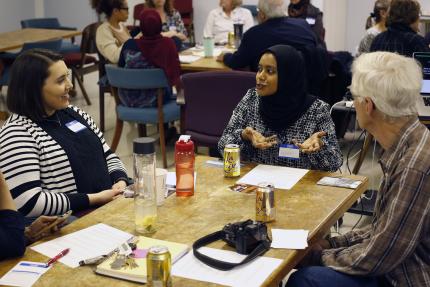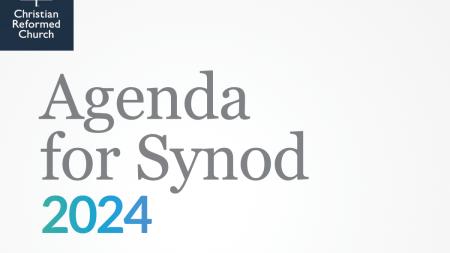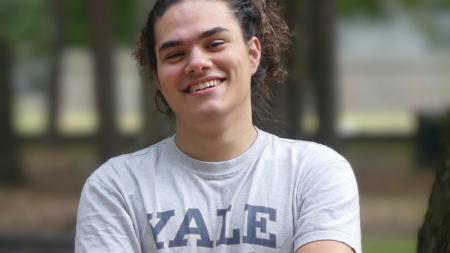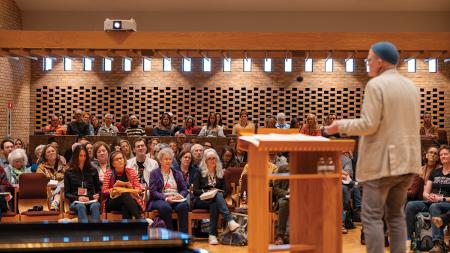Photovoice Breaks Down Barriers

Muslims and Christians discussing their photographs in Richmond, Virginia .
Roman Williams
Roman Williams believes that snapping photos on your cell phone and then sharing and discussing them with one another can be a helpful way to break down barriers in a local church.
In addition, said the Calvin College sociologist, this technique — called photovoice — can be used to open paths for dialogue between people of different faiths.
Since 2015, Williams has been using this tool in churches and in other religious settings and has seen positive, eye-opening results. And in 2018, he and other researchers began using it to establish interfaith dialogue in cities in the U.S. and Canada.
“Feedback has been positive,” he said. “People appreciate the opportunity to sit down face to face and shoulder to shoulder to have conversations about images they have taken.”
Conversations that people have as they discuss their cell-phone photos allow them, said Williams, “to think critically about their shared experiences, and build relationships with their co-participants as they discuss photographs of their congregation and community.”
Photovoice is a research and engagement technique that has been used for several years in a variety of places to gather people to share and discuss photos for various purposes. But using it to help churches address common issues, or to have people of different faiths come together, is relatively new.
In an article to be published in the journal Ecclesial Practices, Williams writes: “Over the last four years, a systematic analysis of the literature found that only a small number of articles focus on religion across many disciplines that employ photovoice.”
As best he can tell, then, said Williams, he and his collaborators are moving into new and exciting territory and finding a way for churches and others to build bridges and address issues they face by using their cell phones.
“I do think photovoice is one example of a way sociology can be employed to engage a community around challenging questions and come up with positive strategies for addressing them,” said Williams.
Photovoice for a Congregation
Rivertown Church (not its real name) is located in a middle-class, predominantly white community in the midwestern U.S. The church’s discipleship pastor contacted Williams and asked him to speak to the church and offer sociological insights about differences between young people and adults and possibly offer suggestions on ways to bring them closer.
This led to the initial “Congregational Self-Portrait Workshop,” which was held in February 2015 and has since been offered in other congregations and nonprofits.
Williams said he began by sitting down with Rivertown church members to lay out the process and to send them off to take photos that helped to depict the life — both positive and negative — of their congregation.
During a handful of meetings, people met to share their photos and give “voice” to what the photos showed.
“Photovoice allows people to gather around the same watering hole,” said Williams. “They see and discuss things that can be troubling or perplexing” — or surprisingly good and healthy — about their congregation.
Some photos highlighted the joys of church life, showing people smiling and sharing meals. But others were more critical.
“For example,” he said, “one participant’s photos satirized the church’s outdated website, and another’s articulated concern about the lack of attendance at the church’s early service on Sundays — using a staged photo of five people worshiping in an otherwise empty sanctuary.”
Participants say they appreciated being included in this exercise. Kevin, a middle-aged member of Rivertown, suggested that “one of the real values of the [workshop] was to be able to stop, pause, consider, and say, ‘I’m not going to walk by this; instead I’m going to ask questions like, “What message is this sending to someone who is brand new?’ . . . or, ‘What message is this sending as it relates to our church’s purpose?’”
Julie, another church member, added: “I enjoyed . . . gaining a different perspective on how I see things and other people.”
Interfaith Dialogue
In 2016, Williams grew increasingly troubled by the way U.S. immigration officials were clamping down on allowing refugees into the country.
As a Christian, he believes Christ has called people to extend hospitality to strangers and foreigners.
He wasn’t sure what to do about this until he recalled a quote from the Roman Catholic priest and theologian Gustavo Gutierrez, who wrote: “You say you are concerned for the poor? Then tell me their name.”
Williams said he was “deeply challenged” when he reworded Gutierrez’s statement this way: “You say you are concerned for your Muslim neighbors and immigrants? Then tell me their names.” By his own admission, added Williams, the list of people he could name was decidedly short.
He began to think hard about Muslim immigrants — people he knew very little about — and then in 2017 he had a discussion over lunch with his friend Michael Bos, a Reformed Church in America pastor in New York City who has long been involved in building bridges with people of different faiths.
“While daunted by the magnitude of the problem [of immigration], we also recognized that we could not stand by and do nothing,” said Williams.
“Out of that initial conversation a small seed was planted.” said Williams. They they came up with the idea of “leveraging Michael’s experience in interfaith dialogue work and my experience in photovoice to do our part in addressing issues important to the church and to society.”
In a relatively short time, they received a grant from the Louisville Institute to help them launch photovoice projects connecting Christians and Muslims in four locations: Grand Rapids, Mich.; New York City; Fredericton, N.B.; and Richmond, Va. They chose these places because the people running and evaluating the project are based in these cities.
The project began in Richmond, where the Muslim population seems to be growing steadily. The city has eight mosques and a Muslim school.
After recruiting a group of eight Muslims and 13 Christians, they began the picture-sharing dialogue early in 2018.
While most of the participants engaged in faith-based activities and “attended religious services once or twice a week, . . . for nearly half of the group this was their first time participating in formal interfaith dialogue,” Williams and his colleagues write in a piece to be published in the Annual Review of the Sociology of Religion.
Participants were invited to create between 10-15 photos that explored their faith in everyday life; challenges they face as a person of faith in their community; and changes they would like to pursue to strengthen their community.
They met for three discussions, sitting around tables in small groups and reviewing their photos. “In this project,” said Williams, “we helped [Christians] come into contact with people of other faiths, and especially with those who are Muslim, to become aware of how they are struggling in our midst.”
Participants eventually made larger copies of their photos and displayed them according to themes for a month-long exhibition at a Richmond library.
One set of photos described “the brokenness of the world” by showing images of people who are homeless. Under the theme of ritual and tradition, there were contrasting photos of approaches to prayer. There were also photos of nature from both Christians and Muslims. One Muslim woman took photos depicting the struggle over whether or not to wear the hijab head covering.
One photo showing city streets with fast-food restaurants sparked a conversation between participants about how hard it can be for Muslims to find the properly prepared food for them to eat in these places.
Hearing this, a Christian participant said it made him realize for the first time that a lack of restaurants Muslims could eat at is “something that they are cognizant of all the time.”
During discussions, Christians were surprised to learn that Muslims recognize many of the stories and characters in the Old Testament. Muslims appreciated seeing a photo of a Christian woman showing off a purity ring, signifying she would remain chaste until marriage, something many Muslims believe is important.
The results from other photovoice projects are now coming in.
And overall, participating groups have found that sitting at a table and reviewing each other’s photos opens up wide-ranging discussions and starts to create avenues of mutual understanding.
Going through this process in Richmond, said Williams, “challenged taken-for-granted assumptions and forged meaningful bonds within the group. Participants also engaged the community of Richmond through their month-long exhibition. . . . Ultimately, photovoice enabled participants, researchers, and others who viewed their exhibition to see the world through one another’s lenses.”
In other words, he added, they were able to get to know each other’s names.
Williams is excited by a recent development that will allow his team to do a project in a majority Muslim country. Likewise, he is eager to facilitate photovoice workshops in North American congregations to help them understand their congregations and communities in new ways.
“After all,” Williams suggested, “if a photo is worth 1,000 words, encouraging conversations about pictures could have a robust impact on relationships, programs, and strategic plans.”


